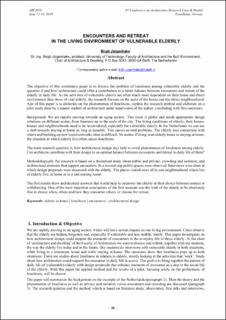| dc.description.abstract | The objective of this conference paper is to discuss the problem of loneliness among vulnerable elderly and the question if and how architecture could offer a contribution to a better balance between encounters and retreat of the elderly in daily life. As the activities of vulnerable elderly are often much more dependent on their home and direct environment than those of vital elderly, the research focuses on the scale of the house and the direct neighbourhood. Aim of this paper is to elaborate on the phenomenon of loneliness, explain the research method and elaborate on a pilot study done by a master student of architecture under supervision of the author, concluding with first outcomes.
Background: We are rapidly moving towards an aging society. This trend is global and needs appropriate design solutions on different scales, from furniture up to the scale of the city. The living conditions of elderly, their homes, houses and neighbourhoods need to be reconsidered, especially for vulnerable elderly. In the Netherlands we can see a shift towards staying at home as long as possible. This causes several problems. The elderly lose connection with others and building up new social networks often is difficult. No matter if living in an elderly home or staying at home, the situation in which elderly live often causes loneliness.
The main research question is, how architectural design may help to avoid phenomenon of loneliness among elderly. Can architects contribute with their design to an optimal balance between encounters and retreat in daily life of them?
Methodologically the research is based on a theoretical study about public and private, crowding and isolation, and architectural elements that support encounters. In a second step public spaces were observed. Interviews were done in which design proposals were discussed with the elderly. The places visited were all in one neighbourhood where lots of elderly live, at home or in a and nursing home.
The first results show architectural answers that would help to empower the elderly in their choice between contact or withdrawing. One of the most important conclusions of the first sessions was the wish of the elderly to be absolutely free in choice when, where and how they encounter others, or choose for retreat. | en_US |

